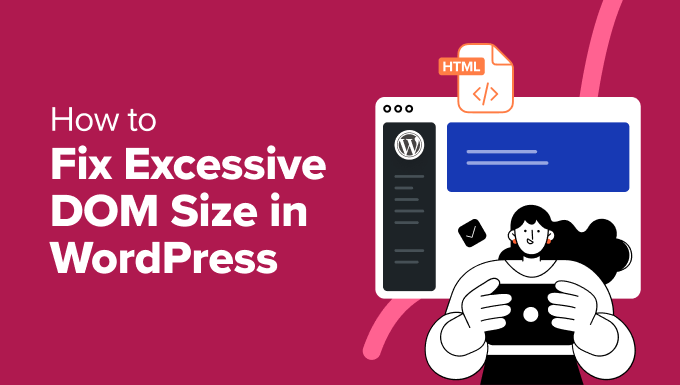How to Fix Excessive DOM Size in WordPress: 11 Expert Tips
A bloated Document Object Model (DOM) can cripple your WordPress website’s performance. It leads to slower page load times, increased browser processing, and a frustrating user experience. Think of it like this: the DOM is the structure of your web page, and a large DOM is like a house filled with too much unnecessary furniture. Cleaning it up is crucial for optimal website performance. This article provides 11 actionable tips to drastically reduce your DOM size and boost your website’s speed.
What is DOM Size and Why Does it Matter?
The DOM is a tree-like representation of the HTML elements on a web page. The more elements (tags, text, attributes) within your HTML, the larger the DOM. Browsers use the DOM to render and interact with the page. A large DOM puts a strain on the browser’s resources, leading to:
- Slower rendering: The browser has to process a massive amount of data.
- Increased memory usage: A large DOM consumes more RAM.
- Poor interaction: JavaScript interactions become sluggish and unresponsive.
- SEO impact: Google considers page speed a ranking factor.
In short, a smaller DOM translates to a faster, more responsive website that users will enjoy and search engines will favor.
1. Choose a Lightweight WordPress Theme
Your WordPress theme is the foundation of your website’s structure. Bloated themes, often filled with unnecessary features and complex layouts, contribute significantly to DOM size. Opt for a lightweight, well-coded theme with minimal dependencies.
- Look for themes with a focus on speed and performance.
- Consider themes with minimal reliance on heavy JavaScript libraries.
- Read reviews and check performance metrics before choosing a theme.
Examples of lightweight themes include GeneratePress, Astra, and OceanWP. These themes are designed to be fast and flexible, allowing you to build a custom design without unnecessary overhead.
2. Eliminate Unnecessary Plugins
Plugins are essential for extending WordPress functionality, but they can also significantly increase DOM size if not managed carefully. Each plugin adds its own code and elements to your website, contributing to the overall DOM complexity. Deactivate and delete any plugins you’re not actively using.
- Regularly audit your installed plugins.
- Deactivate plugins that are no longer needed.
- Consider replacing multiple plugins with a single, more efficient alternative.
Before installing a new plugin, consider whether you can achieve the same functionality with existing plugins or custom code. Avoid plugins that add unnecessary bloat to your website.
3. Optimize Images
While not directly adding to the DOM, large image files can significantly impact perceived loading speed and indirectly affect the user experience, making them seem like they are part of the DOM bloat. Optimize your images by compressing them without sacrificing quality.
- Use image optimization plugins like Smush, ShortPixel, or Imagify.
- Resize images to the dimensions required for your website.
- Choose the appropriate image format (JPEG for photos, PNG for graphics).
Properly optimized images contribute to a faster overall loading experience, making the website feel snappier and more responsive, thus indirectly mitigating the impact of a large DOM.
4. Lazy Load Images and Iframes
Lazy loading defers the loading of images and iframes until they are visible in the viewport. This reduces the initial DOM size and improves page load time, especially for pages with numerous images or embedded content.
Many WordPress themes and plugins offer built-in lazy loading functionality. Alternatively, you can use a dedicated lazy loading plugin.
5. Minify HTML, CSS, and JavaScript
Minification removes unnecessary characters (whitespace, comments) from your HTML, CSS, and JavaScript files, reducing their file size. Smaller files load faster, contributing to a faster overall page load time.
Use a plugin like Autoptimize, WP Rocket, or Hummingbird to minify your website’s code.
6. Remove Unnecessary HTML Elements
Inspect your website’s code using your browser’s developer tools and identify any unnecessary HTML elements that can be removed without affecting the design or functionality. This includes extra divs, empty spans, or redundant wrappers.
7. Limit the Number of DOM Nodes
The fewer DOM nodes, the better. Avoid deeply nested elements and excessive use of divs. Simplify your website’s structure by using semantic HTML5 tags where appropriate.
Semantic HTML5 tags (e.g., <article>, <nav>, <aside>, <header>, <footer>) not only improve accessibility but can also help reduce DOM complexity.
8. Use CSS Sprites
CSS sprites combine multiple images into a single image file. This reduces the number of HTTP requests required to load your website’s images, improving performance.
While modern HTTP/2 can handle more requests, using sprites for small, frequently used icons can still offer performance benefits.
9. Optimize Your WordPress Database
A bloated WordPress database can slow down your website and indirectly contribute to a large DOM. Regularly optimize your database by removing unnecessary data, such as post revisions, spam comments, and transient options.
Use a plugin like WP-Optimize or Advanced Database Cleaner to clean and optimize your database.
10. Implement Content Delivery Network (CDN)
A CDN distributes your website’s files across multiple servers located around the world. This allows users to download files from the server closest to their location, reducing latency and improving page load time. While it doesn’t directly reduce DOM size, it helps reduce the impact a larger DOM might have on load times.
11. Regularly Audit Your Website’s Performance
Use tools like Google PageSpeed Insights, GTmetrix, or WebPageTest to monitor your website’s performance and identify areas for improvement. Pay close attention to the DOM size metric and implement the tips outlined in this article to reduce it.
Regularly monitoring your website’s performance is crucial for maintaining optimal speed and a positive user experience. By addressing DOM size issues and other performance bottlenecks, you can ensure that your website remains fast, responsive, and engaging for your visitors.

